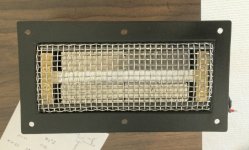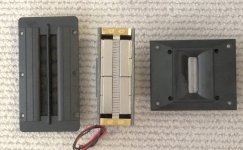
Tested using a 2.2uf, I have add 12Ohms resistor to the tweeter in order to make the SPL match with a 92dB fullrange speaker
The 100 over dB is just a small bandwidth, rest of the spl falls slight above 90dB, probably i need to design a proper crossover.
Finally finished tweeters!
I finally finished the 4 inch ribbon tweeters. I figure 4 of them is enough! They were a lot of work to make look good. They are over twice as loud as any tweeter I have bought and a lot clearer.
Ray
____________________________________________
If brute force doesn't work, your not using enough of it!
I finally finished the 4 inch ribbon tweeters. I figure 4 of them is enough! They were a lot of work to make look good. They are over twice as loud as any tweeter I have bought and a lot clearer.
Ray
____________________________________________
If brute force doesn't work, your not using enough of it!
Attachments
Hi Guys,
I need some assistance I have recently built a transformer for a ribbon tweeter. I measured 4.57 mh on the primary with the core without the core 0.57 mh wire resistance. The question is do I calculate the xo on the primary wire resistance or the core and wire resistance?
Cheers
I need some assistance I have recently built a transformer for a ribbon tweeter. I measured 4.57 mh on the primary with the core without the core 0.57 mh wire resistance. The question is do I calculate the xo on the primary wire resistance or the core and wire resistance?
Cheers
Often unless you really know what your doin the calcs dont always give what you think they should.
I would just start with anywhere from 3 to 5 turns on the secondary and wind the primary till ya get whatever Z' your lookin for.
For smaller ribbons I often end up with around 3 turns secondary and about 40-50 turns primary. This of course is ballpark and you can add/subtract pri. winds till you get Z you want.
What size is the ribbon? width /length/thick? and what freq range and system power do you want to handle
I would just start with anywhere from 3 to 5 turns on the secondary and wind the primary till ya get whatever Z' your lookin for.
For smaller ribbons I often end up with around 3 turns secondary and about 40-50 turns primary. This of course is ballpark and you can add/subtract pri. winds till you get Z you want.
What size is the ribbon? width /length/thick? and what freq range and system power do you want to handle
Often unless you really know what your doin the calcs dont always give what you think they should.
I would just start with anywhere from 3 to 5 turns on the secondary and wind the primary till ya get whatever Z' your lookin for.
For smaller ribbons I often end up with around 3 turns secondary and about 40-50 turns primary. This of course is ballpark and you can add/subtract pri. winds till you get Z you want.
What size is the ribbon? width /length/thick? and what freq range and system power do you want to handle
Lowpass,
I am building a super tweeter I have calculated the correct ratio but I am just not sure if the inductance of the core and wire are taking into account with the xo? It's a 6mm wide by 50mm long but it only needs to work from 15khz. I build big Apogee planar ribbons so I dont really bother with transformers normally.
If You are planning to use the transformer primary inductance as a part of a second order high pass filter you must calculate with the core in place. The resistance of the wire doesn't play any role when it comes to x-over frequency...
If You are planning to use the transformer primary inductance as a part of a second order high pass filter you must calculate with the core in place. The resistance of the wire doesn't play any role when it comes to x-over frequency...
I am not planning on incorporating the inductance of the core but the question do I need to factor the inductance in the xo. The ribbon measures 8 ohms after the transformer and sounds good with a single 3uf Cap but is the inductance playing a role in xo frequency and lowering it with the high inductance?
I' ve built many transformer driven ribbons and I think the best way is to experiment, and measure with mic in between.
I' ve built many transformer driven ribbons and I think the best way is to experiment, and measure with mic in between.
agree
The last ribbon I worked I built half a dozen diff. trans. small core, med core, large core, silicon iron AND amorphous core.
In the end you find you reach point of diminished returns quickly. There really is no black art, its just trial and error and ribbon transformers are simple.
BTW I wouldnt get too misty eyed about amorphous. Yes they have a technical advantage BUT there is much more to good sound than just chasing theoretical ideals.
Once we did blind tests going back and forth between silicon iron and amorphous cores. In the end we actually chose the silicon iron most of the time. I dont know why this is exactly BUT my guess is that the amorphous was a bit "edgier" sounding on everything but the absolute best source material and equipment. Everything else had the standard cores sounding better. Hysteresis is a form of damping and perhaps a bit of softing from those cores was simply more plesant sounding on many recordings ? Im not sure. I know that will be a hard pill to swallow for many and it was for us too.
Last edited:
- Status
- Not open for further replies.
- Home
- Loudspeakers
- Planars & Exotics
- How to make a good transformer for ribbon tweeter?


